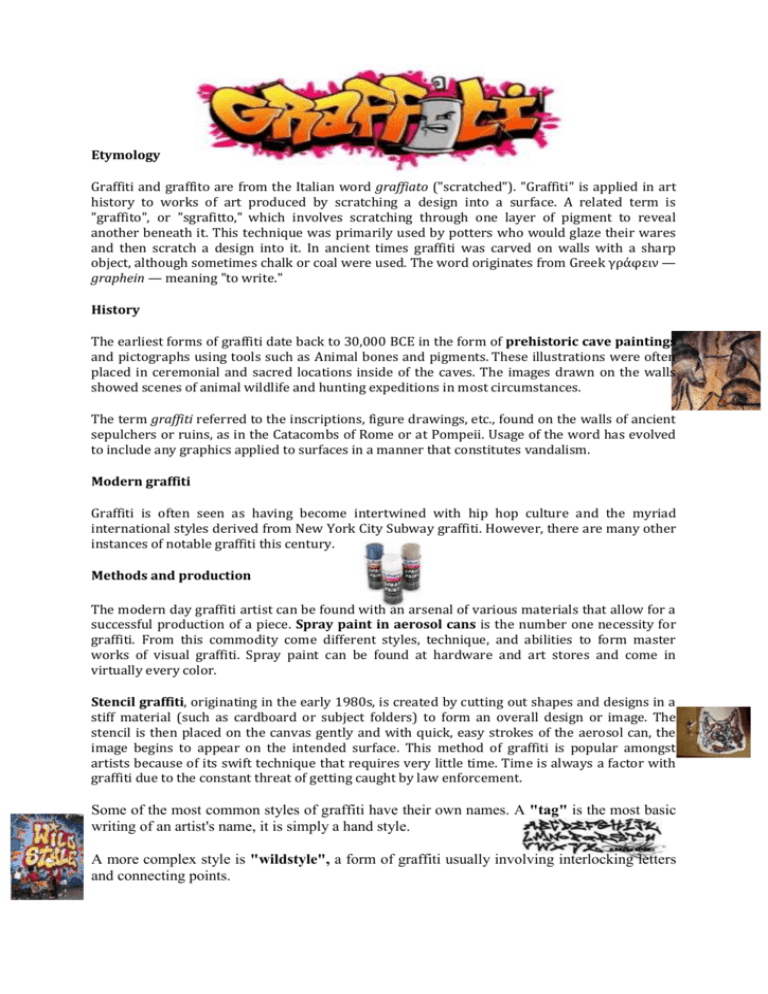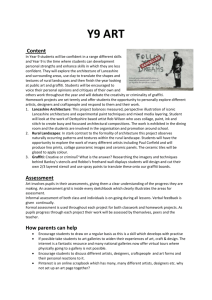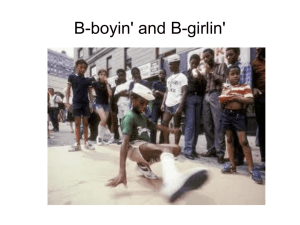CE – Graffiti Story Text
advertisement

Etymology Graffiti and graffito are from the Italian word graffiato ("scratched"). "Graffiti" is applied in art history to works of art produced by scratching a design into a surface. A related term is "graffito", or "sgrafitto," which involves scratching through one layer of pigment to reveal another beneath it. This technique was primarily used by potters who would glaze their wares and then scratch a design into it. In ancient times graffiti was carved on walls with a sharp object, although sometimes chalk or coal were used. The word originates from Greek γράφειν — graphein — meaning "to write." History The earliest forms of graffiti date back to 30,000 BCE in the form of prehistoric cave paintings and pictographs using tools such as Animal bones and pigments. These illustrations were often placed in ceremonial and sacred locations inside of the caves. The images drawn on the walls showed scenes of animal wildlife and hunting expeditions in most circumstances. The term graffiti referred to the inscriptions, figure drawings, etc., found on the walls of ancient sepulchers or ruins, as in the Catacombs of Rome or at Pompeii. Usage of the word has evolved to include any graphics applied to surfaces in a manner that constitutes vandalism. Modern graffiti Graffiti is often seen as having become intertwined with hip hop culture and the myriad international styles derived from New York City Subway graffiti. However, there are many other instances of notable graffiti this century. Methods and production The modern day graffiti artist can be found with an arsenal of various materials that allow for a successful production of a piece. Spray paint in aerosol cans is the number one necessity for graffiti. From this commodity come different styles, technique, and abilities to form master works of visual graffiti. Spray paint can be found at hardware and art stores and come in virtually every color. Stencil graffiti, originating in the early 1980s, is created by cutting out shapes and designs in a stiff material (such as cardboard or subject folders) to form an overall design or image. The stencil is then placed on the canvas gently and with quick, easy strokes of the aerosol can, the image begins to appear on the intended surface. This method of graffiti is popular amongst artists because of its swift technique that requires very little time. Time is always a factor with graffiti due to the constant threat of getting caught by law enforcement. Some of the most common styles of graffiti have their own names. A "tag" is the most basic writing of an artist's name, it is simply a hand style. A more complex style is "wildstyle", a form of graffiti usually involving interlocking letters and connecting points. Uses Theories on the use of graffiti by contemporary analysts and even art critics have begun to see artistic value in some graffiti and to recognize it as a form of public art and an effective tool of social emancipation or in the achievement of a political goal. The murals of Belfast and of Los Angeles offer another example of official recognition. In times of conflict, such murals have offered a means of communication and self-expression for members of these socially, ethnically and/or racially divided communities, and have proven themselves as effective tools in establishing dialog and thus of addressing cleavages in the long run. Both sides of the conflict in Northern Ireland produce political graffiti. As well as slogans, Northern Irish political graffiti include large wall paintings, referred to as murals. The Berlin Wall was also extensively covered by Graffiti reflecting social pressures relating to the oppressive Soviet rule over the GDR. Territorial graffiti serves as marking ground to display tags and logos that differentiate certain groups from others. These images are meant to show outsiders a stern look at whose turf is whose. The subject matter of gang related graffiti consists of cryptic symbols and initials strictly fashioned with unique calligraphies. Gang members use graffiti to designate membership throughout the gang, to differentiate rivals and associates and, most commonly, to mark borders which are both territorial and ideological. Famous street artists and lots of anonymous ones… Banksy is one of the world's most notorious and popular street artist who continues to remain faceless in today's society. He is known for his political, anti-war stencil art mainly in Bristol, England but his work can be seen anywhere from Los Angeles to Palestine. In the UK, Banksy is the most recognizable icon for this cultural artistic movement and keeps his identity a secret to avoid arrest. Much of Banksy's artwork can be seen around the streets of London and surrounding suburbs, though he has painted pictures around the world, including the Middle East, where he has painted on Israel's controversial West Bank barrier with satirical images of life on the other side. One depicted a hole in the wall with an idyllic beach, while another shows a mountain landscape on the other side. A number of exhibitions have also taken place since 2000, and recent works of art have fetched vast sums of money. Banksy's art is a prime example of the classic controversy: vandalism vs. art. Art supporters endorse his work distributed in urban areas as pieces of art and some councils, such as Bristol and Islington, have officially protected them, while other officials have deemed his work to be vandalism and have removed it.= Keith Haring was another well-known graffiti artist who brought Pop Art and graffiti to the commercial mainstream. In the 1980s, Haring opened his first Pop Shop: a store that offered everyone access to his works—which until then could only be found spray-painted on city walls. Pop Shop offered commodities like bags and t-shirts. Graffiti artists constantly have the looming threat of facing consequences for displaying their graffiti. Many choose to protect their identities and reputation by remaining anonymous.






